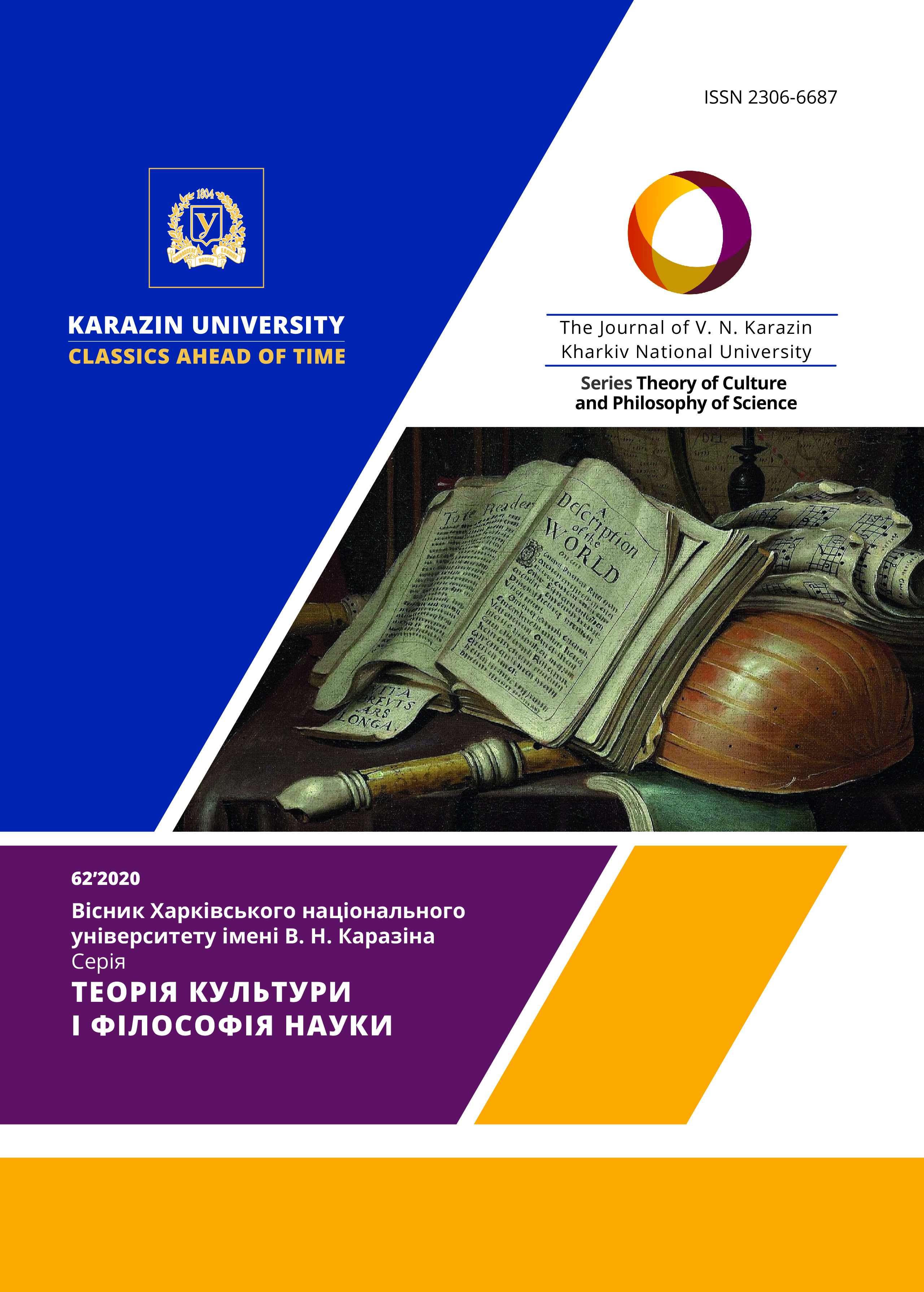HOLOCAUST REPRESENTATIONS IN PAINTING BY FELIX NUSSBAUM
Abstract
The article is devoted to the analysis of Holocaust representations in Felix Nussbaum’s paintings according to historical-philosophical, visual-anthropological, semiotic analysis. Topic of the article is justified by insufficient study of Holocaust images in painting, including the way of representation the memory of the Jewish genocide in painting, experience of deportation to death camps, Holocaust traumas. The relevance of the article is due to insufficient study of the work of the German artist of Jewish origin Felix Nussbaum, who was a victim of Holocaust. Nussbaum as an artist represents an artistic movement «New Objectivity» which was focused on reflecting real essence of things; the artist was also influenced by modernist movements as well as the anti-Nazi one. Nussbaum is a victim of Holocaust who was forced to flee from Germany with his family, constantly go into hiding, and in the end he perished in the concentration camp Auschwitz. Significant period of Nussbaum’s legacy is dedicated to the reflection of horrors in the camp Saint-Cyprien (an internment camp), where he was sent. The author considers the concepts of cultural memory in foreign historiography, concepts of the existentialism philosophy, through the prism of which he analyzes the practices of Jewish genocide (Jewish isolation, destiny of refugees, etc.) and what images panting used for its representation. The article investigates, how events of Holocaust affected the formation of artist`s subjectivity, his artistic manner, symbols and artistic means which he uses in his works. In the perspective of visual-anthropological analysis author highlights problematic topics and typology of images, which were reflected in the paintings of Felix Nussbaum, namely: traumatic experience of emigration for survival, experience of deportation and life in the camp, feelings of fear and approaching of death, family theme and personal experiences of the Holocaust. The author highlights autobiographical, historical-philosophical, artistic aspects of Felix Nussbaum`s paintings. The article considers what artistic means Nussbaum used to oppose the policy of Jewish genocide through painting. Based on Felix Nussbaum’s work, the author analyses how the artist depicts «traumatic places» (based on Aleida Assmann), and how he expresses his traumatic experience in artistic images.
Downloads
References
Adorno, T. (2003). After Auschwitz. In Theodor W. Adorno, Negative Dialectics (pp. 322-333). Moscow, Scientific World. (In Russian).
Arendt, H. (2016). We are refugees (E. Monastyrskiy, Trans.). Online magazine GEFTER. (Original work published in 1994). Retrieved from: http://gefter.ru/archive/18962. (In Russian).
Assmann, A. (2012). Spaces of memory. Forms and transformations of cultural memory (K. Dmitrenko, L. Doronicheva, O. Yudin, Trans.). Kyiv, Nika-Centre. (In Ukrainian).
Bretholz, L. & Olesker, M. (2013). Leap into Darkness: Seven Years on the Run in Wartime Europe (G. Karner, C. Pustilnikova, Trans.). Moscow, OGI. Retrieved from: https://litresp.com/chitat/ru/Б/bretholjc-leo/prizhok-v-temnotu-semj-let-begstva-po-voennoj-evrope#sec_10. (In Russian).
Bruchfeld, S. & Levin, P. (2018). Pass this on to your children…: History of the Holocaust in Europe 1933 – 1945 (Second Ukrainian publishing, supplemented and expanded). Dnipro, Ukrainian Institute for Holocaust Studies «Tkuma». (In Ukrainian).
Vayshelbaum, D. (2013). Felix Nussbaum – life and work. Left radical. Anti-fascism / Visual arts. Retrieved from: https://levoradikal.ru/archives/9410. (In Russian).
Koyfmann, V. (2018). World star of Felix Nussbaum (1904 – 1944). Self portrait in hiding (1944). LiveInternet. Retrieved from: https://www.liveinternet.ru/users/feigele/post441356273/. (In Russian).
Levinas, E. (2004). Difficult freedom (essays on Judaism). In: E. Levinas. Selected: Difficult freedom. (Trans. from French, pp. 319-590). Moscow, ROSSPEN. Retrieved from: http://filosof.historic.ru/books/item/f00/s01/z0001017/st000.shtml. (In Russian).
Lotman, Y. (1998). Structure of fiction text. Saint Petersburg, Art. (In Russian).
Nora, P. (1999). Issues of memory spaces. In: P. Nora, M. Ozouf, G. de Puymezh & M. Wienock. Rethinking France (D. Hapaeva, Trans. from French, pp. 17-50). Saint Petersburg, Publishing of Saint Petersburg University, 1999. (In Russian).
Pyshnovskaya, Z. (1976). German anti-fascist artists: cultural-historical essay. Moscow, Science. (In Russian).
Rotenberg, V. (2005). Felix Nussbaum as a phenomenon and symbol. Nota Bene, 8, 261-265. Retrieved from: https://vtoraya-literatura.com/pdf/nota_bene_08_2005__ocr.pdf. (In Russian).
Sartre, J.-P. (2000). Being and Nothingness: An Essay on Phenomenological Ontology. (V. Kolyadko, Foreword, note). Moscow, Republic. (In Russian).
Snyder, T. (2015). Bloodlands: Europe Between Hitler and Stalin. (L. Zurnadzhy, Trans. from English). Kyiv, Duliby. (In Russian).
Sologub, T. (2017). «If I disappear…» (A story about an artist who reflected the Holocaust in his paintings). Fates of Holocaust, 11, 26-31). Retrieved from: https://www.netzulim.org/R/OrgR/Articles/Baranovskaia/BaranJournals/BaranJournal_no11_15-02-17-Ver.pdf. (In Russian).
Sukovataya, V. (2018). Reception of the war and the Holocaust in the Soviet post-war literature: documentary story by A. Tsessarskiy «Partisan Doctor's Notes». Problems of Holocaust history: Ukrainian dimension. Referenced Annual Journal, 94-121. Dnipro, Ukrainian Institute for Holocaust Studies «Tkuma»; PC «Lyra Ltd.». (In Russian).
Desbois, P. (2008). The Holocaust by Bullets: A Priest's Journey to Uncover the Truth Behind the Murder of 1.5 Million Jews (C. Spencer, Trans. from English). New York, Palgrave Macmillan. (In English).
Elsby, L. Teaching the Holocaust using Art. Yad Vashem. The World Holocaust Remembrance Center. Retrieved from: https://www.yadvashem.org/education/educational-videos/video-toolbox/hevt-art.html#0. (In English).
Meinen, I. & Meyer, A. (2013). Verfolgt von Land zu Land. Jüdische Flüchtlinge in Westeuropa 1938 – 1944. Paderborn, Ferdinand Schöningh. (In German).
Shendar, Y. Felix Nussbaum. Yad Vashem. The World Holocaust Remembrance Center. Retrieved from: https://www.yadvashem.org/yv/en/exhibitions/nussbaum/about_nussbaum.asp. (In English).




